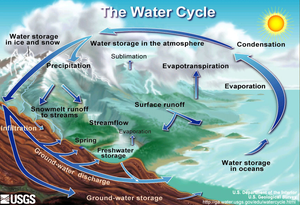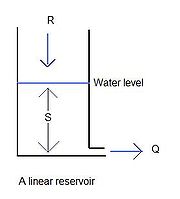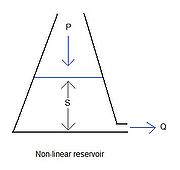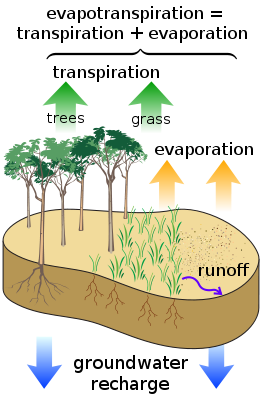.gif)
Runoff model (reservoir)
Encyclopedia
A runoff model is a mathematical model describing the rainfall - runoff
relations of a rainfall catchment area, drainage basin
or watershed. More precisely, it produces the surface runoff hydrograph
as a response to a rainfall hydrograph as input. In other words, the model calculates the conversion of rainfall into runoff.
A well known runoff model is the linear reservoir, but in practice it has limited applicability.
The runoff model with a non-linear reservoir is more universally applicable, but still it holds only for catchments whose surface area is limited by the condition that the rainfall can be considered more or less uniformly distributed over the area. The maximum size of the watershed then depends on the rainfall characteristics of the region. When the study area is too large, it can be divided into sub-catchments and the various runoff hydrographs may be combined using flood routing techniques.
 Rainfall-runoff models need to be calibrated
Rainfall-runoff models need to be calibrated
before they can be used.
 The hydrology of a linear reservoir (figure 1) is governed by two equations.
The hydrology of a linear reservoir (figure 1) is governed by two equations.
where:
Q is the runoff or discharge
R is the effective rainfall or rainfall excess or recharge
A is the constant reaction factor or response factor with unit [1/T]
S is the water storage with unit [L]
dS is a differential or small increment of S
dT is a differential or small increment of T
Runoff equation
A combination of the two previous equations results in a differential equation
, whose solution is:
This is the runoff equation or discharge equation, where Q1 and Q2 are the values of Q at time T1 and T2 respectively while T2−T1 is a small time step during which the recharge can be assumed constant.
Computing the total hydrograph
Provided the value of A is known, the total hydrograph can be obtained using a successive number of time steps and computing, with the runoff equation, the runoff at the end of each time step from the runoff at the end of the previous time step.
Unit hydrograph
The discharge may also be expressed as: Q = − dS/dT . Substituting herein the expression of Q in equation (1) gives the differential equation dS/dT = A.S , of which the solution is: S = exp(− A.t) . Replacing herein S by Q/A according to equation (1) , it is obtained that: Q = A exp(− A.t) . This is called the instantaneous unit hydrograph
(IUH) because the Q herein equals Q2 of the foregoing runoff equation using R = 0 , and taking S as unity which makes Q1 equal to A according to equation (1).
The availability of the foregoing runoff equation eliminates the necessity of calculating the total hydrograph by the summation of partial hydrographs using the IUH as is done with the more complicated convolution
method.
Determining the response factor A
When the response factor A can be determined from the characteristics of the watershed (catchment area), the reservoir can be used as a deterministic model or analytical model , see hydrological modelling
.
Otherwise, the factor A can be determined from a data record of rainfall and runoff using the method explained below under non-linear reservoir. With this method the reservoir can be used as a black box
model.
Conversions
1 mm/day corresponds to 10 m3/day per ha of the watershed
1 l/sec per ha corresponds to 8.64 mm/day or 86.4 m3/day per ha
 Contrary to the linear reservoir, the non linear reservoir has a reaction factor A that is not a constant, but it is a function of S or Q (figure 2, 3).
Contrary to the linear reservoir, the non linear reservoir has a reaction factor A that is not a constant, but it is a function of S or Q (figure 2, 3).
Normally A increases with Q and S because the higher the water level is the higher the discharge capacity becomes. The factor is therefore called Aq instead of A.
The non-linear reservoir has no usable unit hydrograph.
During periods without rainfall or recharge, i.e. when R = 0, the runoff equation reduces to
or, using a unit time step (T2 − T1 = 1) and solving for Aq:
Hence, the reaction or response factor Aq can be determined from runoff or discharge measurements using unit time steps during dry spells, employing a numerical method.
Figure 3 shows the relation between Aq (Alpha) and Q for a small valley (Rogbom) in Sierra Leone.
Figure 4 shows observed and simulated or reconstructed discharge hydrograph
of the watercourse at the downstream end of the same valley.
 The recharge, also called effective rainfall or rainfall excess, can be modeled by a pre-reservoir (figure 6) giving the recharge as overflow. The pre-reservoir knows the following elements:
The recharge, also called effective rainfall or rainfall excess, can be modeled by a pre-reservoir (figure 6) giving the recharge as overflow. The pre-reservoir knows the following elements:
The recharge during a unit time step (T2−T1=1) can be found from R = Rain − Sd
The actual storage at the end of a unit time step is found as Sa2 = Sa1 + Rain − R − Ea, where Sa1 is the actual storage at the start of the time step.
The Curve Number method (CN method) gives another way to calculate the recharge. The initial abstraction herein compares with Sm − Si, where Si is the initial value of Sa.
Vflo
is another software program for modeling runoff. Vflo
uses radar rainfall
and GIS data to generate physics-based, distributed runoff simulation.
The WEAP (Water Evaluation And Planning)
software platform models runoff and percolation from climate and land use data, using a choice of linear and non-linear reservoir models.
Surface runoff
Surface runoff is the water flow that occurs when soil is infiltrated to full capacity and excess water from rain, meltwater, or other sources flows over the land. This is a major component of the water cycle. Runoff that occurs on surfaces before reaching a channel is also called a nonpoint source...
relations of a rainfall catchment area, drainage basin
Drainage basin
A drainage basin is an extent or an area of land where surface water from rain and melting snow or ice converges to a single point, usually the exit of the basin, where the waters join another waterbody, such as a river, lake, reservoir, estuary, wetland, sea, or ocean...
or watershed. More precisely, it produces the surface runoff hydrograph
Hydrograph
A hydrograph is a graph showing the rate of flow versus time past a specific point in a river, or other channel or conduit carrying flow...
as a response to a rainfall hydrograph as input. In other words, the model calculates the conversion of rainfall into runoff.
A well known runoff model is the linear reservoir, but in practice it has limited applicability.
The runoff model with a non-linear reservoir is more universally applicable, but still it holds only for catchments whose surface area is limited by the condition that the rainfall can be considered more or less uniformly distributed over the area. The maximum size of the watershed then depends on the rainfall characteristics of the region. When the study area is too large, it can be divided into sub-catchments and the various runoff hydrographs may be combined using flood routing techniques.

Calibration
Calibration is a comparison between measurements – one of known magnitude or correctness made or set with one device and another measurement made in as similar a way as possible with a second device....
before they can be used.
Linear reservoir

- flow equation: Q = A.S , with units [L/T] , where L is length (e.g. mm) and T is time (e.g. hr, day)
- continuity or water balance equation: R = Q + dS/dT , with units [L/T]
where:
Q is the runoff or discharge
R is the effective rainfall or rainfall excess or recharge
A is the constant reaction factor or response factor with unit [1/T]
S is the water storage with unit [L]
dS is a differential or small increment of S
dT is a differential or small increment of T
Runoff equation
A combination of the two previous equations results in a differential equation
Differential equation
A differential equation is a mathematical equation for an unknown function of one or several variables that relates the values of the function itself and its derivatives of various orders...
, whose solution is:
- Q2 = Q1 exp { −A (T2 − T1) } + R [ 1 − exp { −A (T2 − T1) } ]
This is the runoff equation or discharge equation, where Q1 and Q2 are the values of Q at time T1 and T2 respectively while T2−T1 is a small time step during which the recharge can be assumed constant.
Computing the total hydrograph
Provided the value of A is known, the total hydrograph can be obtained using a successive number of time steps and computing, with the runoff equation, the runoff at the end of each time step from the runoff at the end of the previous time step.
Unit hydrograph
The discharge may also be expressed as: Q = − dS/dT . Substituting herein the expression of Q in equation (1) gives the differential equation dS/dT = A.S , of which the solution is: S = exp(− A.t) . Replacing herein S by Q/A according to equation (1) , it is obtained that: Q = A exp(− A.t) . This is called the instantaneous unit hydrograph
Hydrograph
A hydrograph is a graph showing the rate of flow versus time past a specific point in a river, or other channel or conduit carrying flow...
(IUH) because the Q herein equals Q2 of the foregoing runoff equation using R = 0 , and taking S as unity which makes Q1 equal to A according to equation (1).
The availability of the foregoing runoff equation eliminates the necessity of calculating the total hydrograph by the summation of partial hydrographs using the IUH as is done with the more complicated convolution
Convolution
In mathematics and, in particular, functional analysis, convolution is a mathematical operation on two functions f and g, producing a third function that is typically viewed as a modified version of one of the original functions. Convolution is similar to cross-correlation...
method.
Determining the response factor A
When the response factor A can be determined from the characteristics of the watershed (catchment area), the reservoir can be used as a deterministic model or analytical model , see hydrological modelling
Hydrological modelling
Hydrologic models are simplified, conceptual representations of a part of the hydrologic cycle. They are primarily used for hydrologic prediction and for understanding hydrologic processes. Two major types of hydrologic models can be distinguished:...
.
Otherwise, the factor A can be determined from a data record of rainfall and runoff using the method explained below under non-linear reservoir. With this method the reservoir can be used as a black box
Black box
A black box is a device, object, or system whose inner workings are unknown; only the input, transfer, and output are known characteristics.The term black box can also refer to:-In science and technology:*Black box theory, a philosophical theory...
model.
Conversions
1 mm/day corresponds to 10 m3/day per ha of the watershed
1 l/sec per ha corresponds to 8.64 mm/day or 86.4 m3/day per ha
Non-linear reservoir

Normally A increases with Q and S because the higher the water level is the higher the discharge capacity becomes. The factor is therefore called Aq instead of A.
The non-linear reservoir has no usable unit hydrograph.
During periods without rainfall or recharge, i.e. when R = 0, the runoff equation reduces to
- Q2 = Q1 exp { − Aq (T2 − T1) }, or:
or, using a unit time step (T2 − T1 = 1) and solving for Aq:
- Aq = − ln (Q2/Q1)
Hence, the reaction or response factor Aq can be determined from runoff or discharge measurements using unit time steps during dry spells, employing a numerical method.
Figure 3 shows the relation between Aq (Alpha) and Q for a small valley (Rogbom) in Sierra Leone.
Figure 4 shows observed and simulated or reconstructed discharge hydrograph
Hydrograph
A hydrograph is a graph showing the rate of flow versus time past a specific point in a river, or other channel or conduit carrying flow...
of the watercourse at the downstream end of the same valley.
Recharge

- a maximum storage (Sm) with unit length [L]
- an actual storage (Sa) with unit [L]
- a relative storage: Sr = Sa/Sm
- a maxmimum escape rate (Em) with units length/time [L/T]. It corresponds to the maximum rate of evaporationEvapotranspirationEvapotranspiration is a term used to describe the sum of evaporation and plant transpiration from the Earth's land surface to atmosphere. Evaporation accounts for the movement of water to the air from sources such as the soil, canopy interception, and waterbodies...
plus percolation and groundwater recharge, which will not take part in the runoff process (figure 5, 6) - an actual escape rate: Ea = Sr.Em
- a storage deficiency: Sd = Sm + Ea − Sa
The recharge during a unit time step (T2−T1=1) can be found from R = Rain − Sd
The actual storage at the end of a unit time step is found as Sa2 = Sa1 + Rain − R − Ea, where Sa1 is the actual storage at the start of the time step.
The Curve Number method (CN method) gives another way to calculate the recharge. The initial abstraction herein compares with Sm − Si, where Si is the initial value of Sa.
Software
Figures 3 and 4 were made with the RainOff program, designed to analyse rainfall and runoff using the non-linear reservoir model with a pre-reservoir. The program also contains an example of the hydrograph of an agricultural subsurface drainage system for which the value of A can be obtained from the system's characteristics.Vflo
Vflo
Vflo is a commercially available, physics-based distributed hydrologic model generated by Vflo uses radar rainfall data for hydrologic input to simulate distributed runoff . Vflo employs GIS maps for parameterization via a desktop interface . The model is suited for distributed hydrologic...
is another software program for modeling runoff. Vflo
Vflo
Vflo is a commercially available, physics-based distributed hydrologic model generated by Vflo uses radar rainfall data for hydrologic input to simulate distributed runoff . Vflo employs GIS maps for parameterization via a desktop interface . The model is suited for distributed hydrologic...
uses radar rainfall
Weather radar
Weather radar, also called weather surveillance radar and Doppler weather radar, is a type of radar used to locate precipitation, calculate its motion, estimate its type . Modern weather radars are mostly pulse-Doppler radars, capable of detecting the motion of rain droplets in addition to the...
and GIS data to generate physics-based, distributed runoff simulation.
The WEAP (Water Evaluation And Planning)
WEAP
WEAP: the Water Evaluation And Planning system is a Windows-based decision support system for integrated water resources management and policy analysis...
software platform models runoff and percolation from climate and land use data, using a choice of linear and non-linear reservoir models.

